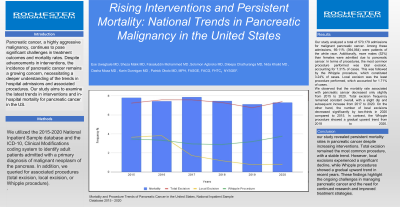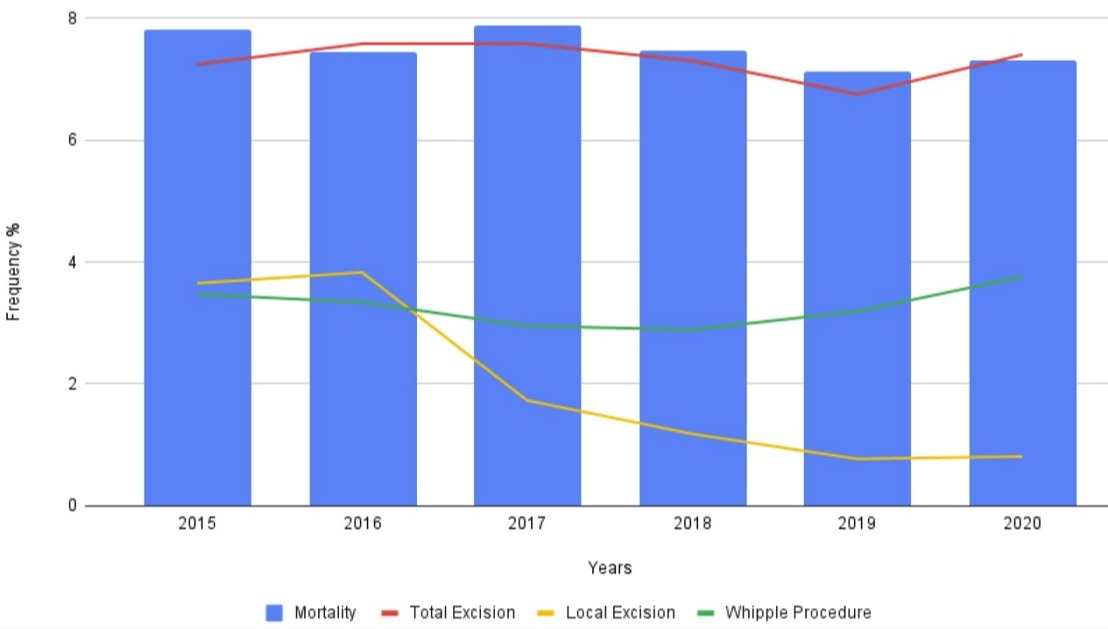Tuesday Poster Session
Category: Biliary/Pancreas
P2848 - Rising Interventions and Persistent Mortality: National Trends in Pancreatic Malignancy in the United States
Tuesday, October 24, 2023
10:30 AM - 4:00 PM PT
Location: Exhibit Hall

Has Audio

Ese Uwagbale, MD
Rochester General Hospital
Rochester, NY
Presenting Author(s)
Ese Uwagbale, MD1, Sheza Malik, MD1, Faisaluddin Mohammed, MD1, Solomon Agbroko, MD2, Dileepa Chathuranga, MD1, Nida Khalid, MD1, Dasha Moza, MD1, Karin Dunnigan, MD1, Patrick Okolo, MD, MPH, FACG1
1Rochester General Hospital, Rochester, NY; 2Maimonides Medical Center, Brooklyn, NY
Introduction: Pancreatic cancer, a highly aggressive malignancy, continues to pose significant challenges in treatment outcomes and mortality rates. Despite advancements in interventions, the incidence of pancreatic cancer remains a growing concern, necessitating a deeper understanding of the trends in hospital admissions and associated procedures. Our study aims to examine the latest trends in interventions and in-hospital mortality for pancreatic cancer in the US.
Methods: We utilized the 2015-2020 National Inpatient Sample database and the ICD-10, Clinical Modifications coding system to identify adult patients admitted with a primary diagnosis of malignant neoplasm of the pancreas. In addition, we queried for associated procedures (total excision, local excision, or Whipple procedure).
Results: Our study analyzed a total of 570,179 admissions for malignant pancreatic cancer. Among these admissions, 69.11% (394,064) were patients of the white race. Additionally, more males (52%) than females were admitted due to pancreatic cancer. In terms of procedures, the most common procedure performed was total excision, accounting for 7.31% of cases. This was followed by the Whipple procedure, which constituted 3.24% of cases. Local excision was the least procedure performed, which accounted for 1.71% of cases.
We observed that the mortality rate associated with pancreatic cancer decreased only slightly from 2015 to 2020. Total excision frequency remained constant overall, with a slight dip and subsequent increase from 2017 to 2020. On the other hand, the number of local excisions decreased significantly by two-thirds in 2020 compared to 2015. In contrast, the Whipple procedure showed a gradual upward trend from 2018 to 2020.
Discussion: In conclusion, our study revealed persistent mortality rates in pancreatic cancer despite increasing interventions. Total excision remained the most common procedure, with a stable trend. However, local excisions experienced a significant decline, while Whipple procedures showed a gradual upward trend in recent years. These findings highlight the ongoing challenges in managing pancreatic cancer and the need for continued research and improved treatment strategies.

Disclosures:
Ese Uwagbale, MD1, Sheza Malik, MD1, Faisaluddin Mohammed, MD1, Solomon Agbroko, MD2, Dileepa Chathuranga, MD1, Nida Khalid, MD1, Dasha Moza, MD1, Karin Dunnigan, MD1, Patrick Okolo, MD, MPH, FACG1. P2848 - Rising Interventions and Persistent Mortality: National Trends in Pancreatic Malignancy in the United States, ACG 2023 Annual Scientific Meeting Abstracts. Vancouver, BC, Canada: American College of Gastroenterology.
1Rochester General Hospital, Rochester, NY; 2Maimonides Medical Center, Brooklyn, NY
Introduction: Pancreatic cancer, a highly aggressive malignancy, continues to pose significant challenges in treatment outcomes and mortality rates. Despite advancements in interventions, the incidence of pancreatic cancer remains a growing concern, necessitating a deeper understanding of the trends in hospital admissions and associated procedures. Our study aims to examine the latest trends in interventions and in-hospital mortality for pancreatic cancer in the US.
Methods: We utilized the 2015-2020 National Inpatient Sample database and the ICD-10, Clinical Modifications coding system to identify adult patients admitted with a primary diagnosis of malignant neoplasm of the pancreas. In addition, we queried for associated procedures (total excision, local excision, or Whipple procedure).
Results: Our study analyzed a total of 570,179 admissions for malignant pancreatic cancer. Among these admissions, 69.11% (394,064) were patients of the white race. Additionally, more males (52%) than females were admitted due to pancreatic cancer. In terms of procedures, the most common procedure performed was total excision, accounting for 7.31% of cases. This was followed by the Whipple procedure, which constituted 3.24% of cases. Local excision was the least procedure performed, which accounted for 1.71% of cases.
We observed that the mortality rate associated with pancreatic cancer decreased only slightly from 2015 to 2020. Total excision frequency remained constant overall, with a slight dip and subsequent increase from 2017 to 2020. On the other hand, the number of local excisions decreased significantly by two-thirds in 2020 compared to 2015. In contrast, the Whipple procedure showed a gradual upward trend from 2018 to 2020.
Discussion: In conclusion, our study revealed persistent mortality rates in pancreatic cancer despite increasing interventions. Total excision remained the most common procedure, with a stable trend. However, local excisions experienced a significant decline, while Whipple procedures showed a gradual upward trend in recent years. These findings highlight the ongoing challenges in managing pancreatic cancer and the need for continued research and improved treatment strategies.

Figure: Mortality and Procedure Trends of Pancreatic Cancer in the United States, National Inpatient Sample Database 2015 - 2020
Disclosures:
Ese Uwagbale indicated no relevant financial relationships.
Sheza Malik indicated no relevant financial relationships.
Faisaluddin Mohammed indicated no relevant financial relationships.
Solomon Agbroko indicated no relevant financial relationships.
Dileepa Chathuranga indicated no relevant financial relationships.
Nida Khalid indicated no relevant financial relationships.
Dasha Moza indicated no relevant financial relationships.
Karin Dunnigan indicated no relevant financial relationships.
Patrick Okolo indicated no relevant financial relationships.
Ese Uwagbale, MD1, Sheza Malik, MD1, Faisaluddin Mohammed, MD1, Solomon Agbroko, MD2, Dileepa Chathuranga, MD1, Nida Khalid, MD1, Dasha Moza, MD1, Karin Dunnigan, MD1, Patrick Okolo, MD, MPH, FACG1. P2848 - Rising Interventions and Persistent Mortality: National Trends in Pancreatic Malignancy in the United States, ACG 2023 Annual Scientific Meeting Abstracts. Vancouver, BC, Canada: American College of Gastroenterology.
